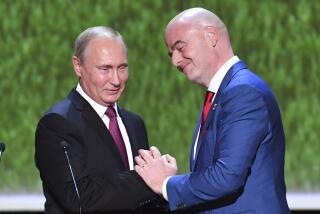Soccer’s top leagues assail plan to push Qatar World Cup to November
A FIFA task force’s recommendation to avoid Qatar’s sweltering summer heat by pushing the start of the 2022 World Cup to November has left European officials a little hot under the collar, igniting a feud between soccer’s world governing body and the sport’s top professional leagues and players.
The World Cup has always been played during the Northern Hemisphere’s summer but in Qatar that would mean dealing with temperatures well above 100 degrees. Moving the tournament to late fall, when average temperatures hover in the high 70s, would avoid the sweltering heat, but the change would wreak havoc with top leagues, most of which play an August-to-May schedule.
Yet that’s exactly what FIFA is expected to do.
“It is the worst solution,” Frederic Thiriez, president of France’s Ligue 1, one of more than four dozen professional leagues that would be affected by the change, told Agence France-Presse. “We are going to stop in November after 13 or 14 games and start again in January. In the meantime, players will not play, the clubs will not make any money, the fans will be deprived of national competitions and television companies will be furious.”
European soccer officials are expected to wage a fierce lobbying campaign against the proposed changes before a vote on the recommendations is held next month. FIFA said Tuesday all its member confederations were in support of the new schedule, which the group said would be ratified at the executive committee meeting March 19-20 in Zurich.
Clubs and leagues could try to change that by threatening to seek compensation for losses caused by an enforced break in their competitions. The European Club Assn. is already calling on FIFA to pay major clubs for the rights to use players in midseason.
“Staging the World Cup in November/December is an organizational as well as a financial burden for European leagues,” Andreas Rettig, managing director for a group representing German leagues, told Reuters.
Major League Soccer, the top domestic league in the U.S. and Canada, would have an easier time with the World Cup change because MLS plays its regular season games from March to October. Accommodating the MLS playoffs, however, would probably require a slightly earlier start to the season.
FIFA’s decision to award the tournament to Qatar instead of the United States, which finished second in the voting, has been controversial from the start, with much of opposition focused on the searing summer heat in the Arab nation.
Recent investigations also have suggested the vote may have been tainted by bribery and corruption, while World Cup construction in Qatar has been marred by the deaths and alleged mistreatment of foreign construction workers.
Nevertheless, FIFA has dismissed calls to move the 2022 World Cup, instead forming a task force to explore changes to the tournament calendar. Virtually every alternative to the traditional summer schedule contained conflicts, though.
Moving the World Cup to January and February, for example, would have avoided the summer heat but it would not alleviate the conflict with most of the world’s domestic leagues. Plus it would set up clash with the Winter Olympics.
An April-May tournament would interrupt the climax of most domestic soccer leagues and overlap with Islam’s observance of Ramadan.
But while the November-December dates would avoid many of those problems, it would also force FIFA to shorten the tournament. The 2014 World Cup in Brazil lasted 32 days; the schedule reportedly being recommended for 2022 would begin about Nov. 26 or 27 and would conclude Dec. 23, so as not to interfere with Christmas.
And that would mean sidelining the vast majority of the world’s top players for six or seven weeks in the middle of their club seasons.
Add another couple of weeks for training camp before the Cup starts, and players whose teams reach the semifinals would miss nearly two months of play for their clubs — who, after all, are the ones who pay the players’ salaries.
Yet continuing league play during the World Cup, as MLS does, isn’t a workable solution for many leagues because it would significantly dilute the competition. The English Premier League sent 105 players to last summer’s tournament, for instance, while Bayern Munich alone had 15 players in Brazil. MLS had 22 players in the tournament.
It also may be difficult for players to immediately return to their club teams after the World Cup. Normally players receive a post-tournament break of as long as a month before reporting to their teams.
That led one union representing players, FIFPro, to voice its own concerns Tuesday.
“Changes to the match schedule … could potentially place extra strain on the workload of the players,” FIFPro said in a statement.
“Very disappointed, that’s the word, I think, on behalf of all the European leagues and particularly the European clubs who provide most of the players for this World Cup,” Richard Scudamore of the English Premier League told AFP.
He added he felt “let down” by European football’s governing body, UEFA, which has already accepted a switch to winter.
“FIFA keep their international dates, they keep their World Cup intact, even UEFA, who, I think, let us down a little bit, clearly pushed this ... so their Champions League can start and carry on again, just like it always does,” he said.
Twitter: @kbaxter11







